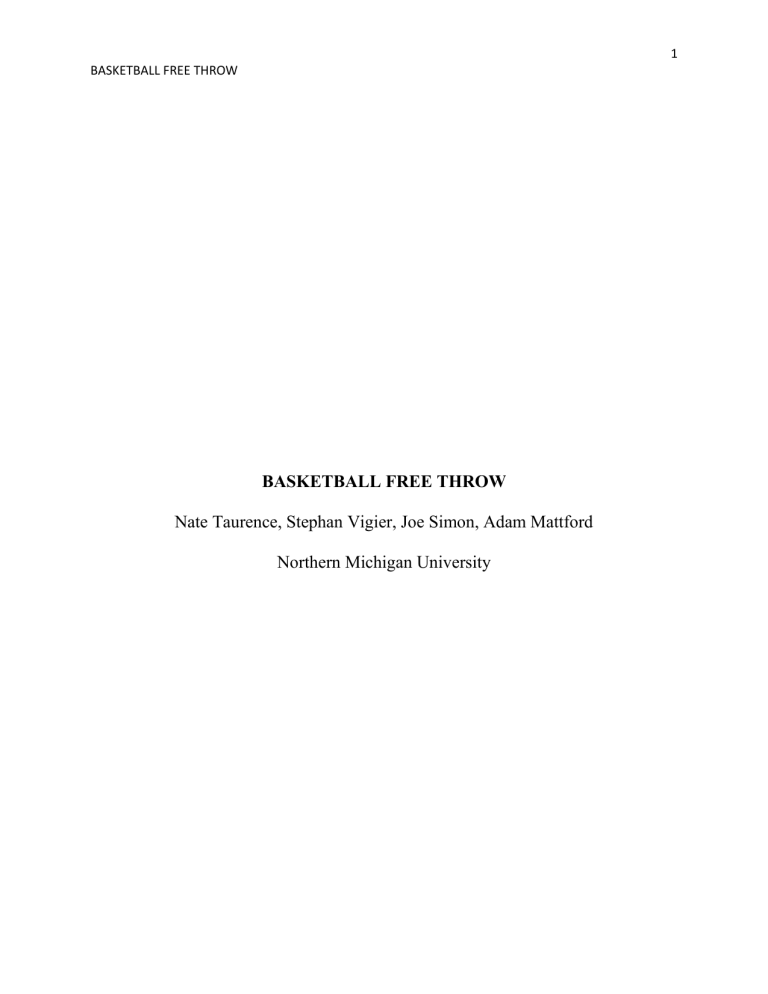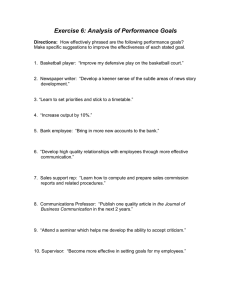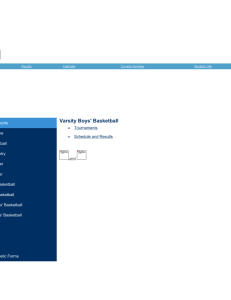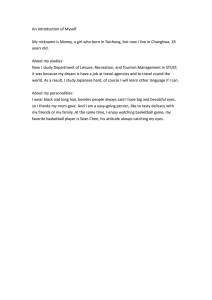
1 BASKETBALL FREE THROW BASKETBALL FREE THROW Nate Taurence, Stephan Vigier, Joe Simon, Adam Mattford Northern Michigan University 2 BASKETBALL FREE THROW ”The free-throw shot is a motion that most basketball players will perform tens or even hundreds of thousands times in their lives, and yet the league average... in the National Basketball Association, was only 76.3 percent.” (Bradley & Martin, 2012) The sport specific skill or movement we have chosen is a basketball free throw. A basketball free throw is a basketball shot worth one point. A player usually gets two attempts at a free throw whether or not they make the first one. Though it does not involve intense muscle contractions there are still many muscles the body must use to perform the proper basketball free throw. Being that we have four people in our group, we have decided to break up the basketball free throw into four phases: stationary phase, preparation phase, action phase, and follow thru phase. When shooting a free throw there are two forces that influence the basketballs projectile: air resistance and gravity. Air resistance is negligible, but gravity is not. Gravity pulls down the ball at about 9.8 m/s. With gravity acting on the ball, the amount of acceleration and velocity the ball has when it leaves the players hands plays a factor on the result of the shot. The three factors that influence the projectile motion of the basketball are: projection height, projection angle, and projection velocity. The projection height is the difference between projection height and landing height. When a player shoots a free throw their feet stay planted on the basketball court so it is just the distance from the floor to the point of release. The projection angle is the direction of projection with respect to the horizontal. If a player shoots a ball at 90 degrees the ball will reach maximum height but it will not move forward. If a player shoots a ball at 45 degrees the ball will travel maximum distance with medial height. Complements that add to 90 degrees will travel the same distance. When shooting a free throw the recommended angle of projection is about 51 degrees. (Tan & Miller, 1980) A higher arc shot has a greater probability of going through the hoop versus a lower arc shot. Projection velocity is the last factor that influences the projectile motion of a basketball free throw. The projection velocity is the instantaneous velocity of the shot at the moment of release. In similar terms, it’s basically the speed of the basketball in the air. A basketball player wants to make sure to put enough velocity on the ball to get it to the net, but not too much where it will rebound out of the net or off the rim. 3 BASKETBALL FREE THROW The spin of a free throw is also very important. The spin will not only affect the projectile motion of the ball but it will also affect the rebound of the basketball. When a basketball player shoots a free throw they put back spin on the ball. Backspin spins causes the basketball to rise because there is a lower pressure above the ball. As stated earlier, a higher trajectory is better for a free throw because it has a better angle to enter the net. The ball spins around the frontal axis. Free throws are not always perfect. Some players rebound the ball into the net off the backboard rather than shooting the ball directly into the hoop. A basketball with backspin will create a higher than normal rebound angle. A basketball with top spin will create a lower than normal rebound angle. A basketball with no spin will rebound at the same angle. This is very important to basketball players because sometimes players need to miss on purpose to get the ball back. Knowing the type of spin the shooter plans on putting on the ball will only increase the probability of the offensive team getting the ball back. When shooting a free throw our bodies use many muscles groups. These groups include the knee extensors, hip extensors, shoulder flexors, ankle extensors, elbow extensors, and the wrist flexors. Every one of these groups plays a major role in a basketball free throw. We will start with the stationary phase. Stationary Phase(Adam Mattford) The first phase is the stationary phase. During the stationary phase the basketball player establishes his base before shooting the ball. The stationary phase consists of the basketball player creating a base with their feet by staggering them about shoulder width apart. That means one foot’s toes are on the free throw line and the other one is slightly behind. There is no movement in this phase because the player is preparing to shoot the ball. All the muscle groups and joints are in a state of isotonic contraction. The body is practically in anatomical position. Preparation Phase (Nate and Stephan) The second phase is the preparation phase. During the preparation phase the basketball player combines the stationary phase with this new phase. The preparation phase consists of the basketball player holding the ball in front of their body with two hands about head level with their knees slightly bent in the athletic position. To move from the stationary phase to the preparation phase, muscles, tendons and joints must work together. When 4 BASKETBALL FREE THROW a basketball player shoots a free throw they do not jump. They keep their feet planted on the free throw line. In order to shoot the ball they must slightly bend their knees for balance. The joint that assists with knee flexion is the knee joint. There are two types of muscle groups that are involved in knee flexion. The agonist muscle group that flexes the knees is the hamstring muscles: semitendinosus; semimembranosus; and bicep femoris. The antagonist muscle group that assists with knee flexion is the quadriceps: rectus femoris; vastus lateralis; vastus intermedias; and vastus medialis. The hamstring muscles contract eccentrically; the muscles actively lengthen as the basketball player flexes their knee. The quadriceps muscles are stabilizers; they contract isotonically. The quadriceps does not lengthen or shorten. The flexion of the knee breaks the sagittal plane and rotates on the frontal horizontal axis. KNEE FLEXION Agonist Semitendinosus Semimembranosus Bicep Femoris Antagonist Rectus Femoris Vastus Lateralis Vastus Intermedias Vastus Medialis Continuing with the preparation phase, a basketball player also uses their ankle joint, also known as the talocrural joint. The angle between the foot and the basketball player’s tibia decreases, creating dorsi flexion in the ankle. The muscles that contract concentrically during dorsi-flexion are: tibialis anterior; extensor digitorum longus; peroneus tertius; extensor halluces longus. The antagonist muscles that contract eccentrically during dorsi flexion are: gastrocnemius; soleus. Dorsi-flexion in the ankle joint breaks the sagittal plane and rotates on the frontal horizontal axis. DORSI FLEXION Agonist Tibialis Anterior Extensor Digitorum Longus Peroneus Tertius Extensor Hallucius Longus Antagonist Gastrocnemius Soleus 5 BASKETBALL FREE THROW During the preparation phase, the basketball player must hold the ball out in front of their head with their elbows slightly bent. The elbow joint flexes when they bend their elbows. The agonist muscles that contract concentrically to flex the elbow are: bicep brachii; brachialis; and the brachioradialis. The antagonist muscles that contract eccentrically during elbow flexion are: tricep brachii; anconeus. The elbow joint breaks the sagittal plane and rotates on the frontal horizontal axis. ELBOW FLEXION Agonist Biceps Brachii Brachialis Brachioradialis Antagonist Triceps Brachii Anconeus When the basketball player holds the ball out in front of their head their shoulder joint flexes. The agonist muscles that contract concentrically with shoulder flexion are the: anterior deltoid; upper pectoralis major. The antagonist muscles that contract eccentrically with shoulder flexion are: teres major; and the latissimus dorsi. The shoulder girdle elevates and upper rotates during shoulder flexion. The shoulder joint breaks the sagittal plane and rotates on the frontal horizontal axis. SHOULDER FLEXION Agonist Anterior Deltoid Upper Pectorial Major Antagonist Teres Major Latissimus Dorsi Holding the basketball with the correct form is very important in the basketball free throw. In the preparation phase, the basketball player must hold the ball. They are not physically shooting the ball just yet. The wrist joint extends which allows the basketball to sit in the palm of the shooters hand. Whether a basketball player is right handed or left handed, the strong wrist must pronate for proper form. The non-dominant wrist stays in the neutral position. The agonist muscles that contract concentrically to extend the wrist joint are: extensor carpi ulnaris; extensor carpi radialis longus; extensor carpi radialis brevis. The antagonist muscles that contract 6 BASKETBALL FREE THROW eccentrically to extend the wrist joint are: flexor carpi ulnaris; flexor carpi radialis; palmars longus. The wrist joint breaks the sagittal plane and rotates on the frontal horizontal axis. WRIST EXTENSION Agonist Extensor Carpi Ulnaris Extensor Carpi Radialis Longus Extensor Carpi Radialis Brevis Antagonist Flexor Carpi Ulnaris Flexor Carpi Radialis Palmaris Longus Action Phase(Nate and Stephan) After the preparation phase is complete, the action phase is next. During this phase, the basketball player must perform the basketball free throw. The action phase uses many of the same muscles and muscle movements as the preparation phase. Though there are many joints that are involved during a basketball free throw, we will examine the five main joints used. The five joints we feel are most important are the knee joints, the ankle joints, the elbow joints, the wrist joints, and the shoulder joints. During the preparation phase the basketball player had to bend their knees creating knee flexion. But in the action phase, the basketball player extends their knee joint. The agonist muscles that contract concentrically extend the knee. These muscles are the quadriceps: rectus femoris; vastus lateralis; vastus intermedius; vastus medialis. The antagonist muscles that contract eccentrically in the knee during knee extension are the hamstrings: semitendinosus; semimembranosus; bicep femoris. The knee joint extends in the sagittal plane and rotates on the frontal horizontal axis. KNEE EXTENSION Agonist Rectus Femoris Vastus Lateralis Vastus Intermedias Vastus Medialis Antagonist Semitendinosus Semimembranosus Bicep Femoris In the preparation phase, the ankle joint dorsi-flexes. But in the action phase, the ankle joint plantar flexes. This is because the angle between the tibia and the foot increases. Though the players’ feet still do not 7 BASKETBALL FREE THROW leave the ground completely, they lift their heel to create plantar flexion. The agonist muscles that contract concentrically during plantar flexion are: gastrocnemius; soleus. The antagonist muscles that contract eccentrically during plantar flexion are: tibialis anterior; extensor digitorum longus; peroneus tertius; extensor hallucis longus. Plantar flexion breaks the sagittal plane and rotates on the frontal horizontal axis. PLANTAR FLEXION Agonist Gastrocnemius Soleus Antagonist Tibialis Anterior Extensor Digitorum Longus Peroneus Tertius Extensor Hallucius Longus Holding the ball during the preparation phase causes the elbow joint to flex. During the action phase the dominant hands’ elbow joint extends. The non-dominant hands’ elbow joint stays flexed from the preparation phase. The agonist muscles that contract concentrically to extend the dominant elbow joint are: triceps brachii; anconeus. The antagonist muscles that contract eccentrically to extend the dominant elbow joint are: biceps brachii; brachialis; brachioradialis. When the elbow joint extends it breaks the sagittal plane on the frontal horizontal axis. ELBOW EXTENSION Agonist Triceps Brachii Anconeus Antagonist Biceps Brachii Brachialis Brachioradialis The shoulder joint stays flexed during the action phase, just like it did during the preparation phase. When the basketball player holds the ball out in front of their head, their shoulder joint flexes. When they shoot the ball the shoulder joint stays flexed. The agonist muscles that contract concentrically with shoulder flexion are the: anterior deltoid; upper pectoralis major. The antagonist muscles that contract eccentrically with shoulder flexion are: teres major; and the latissimus dorsi. The shoulder girdle elevates and upper rotates during shoulder flexion. The shoulder joint breaks the sagittal plane and rotates on the frontal horizontal axis. 8 BASKETBALL FREE THROW SHOULDER FLEXION Agonist Anterior Deltoid Upper Pectorial Major Antagonist Teres Major Latissimus Dorsi The wrist joint helps the basketball player to hold the basketball. During the preparation phase the basketball players wrist joint extends to hold ball with proper form. In the action phase, the wrist joint of the dominant hands’ wrist flexes. The non-dominant hands’ wrist joint does not change. The joint stays extended. The agonist muscles that contract concentrically during wrist flexion for the dominant hand are: flexor carpi ulnaris; flexor carpi radialis; palmars longus. The antagonist muscles that contract eccentrically during wrist flexion for the dominant hand are: extensor carpi ulnaris; extensor carpi radialis longus; extensor carpi radialis brevis. The wrist joint breaks the sagittal plane and rotates on the frontal horizontal axis. WRIST FLEXION Agonist Flexor Carpi Ulnaris Flexor Carpi Radialis Palmaris Longus Antagonist Extensor Carpi Ulnaris Extensor Carpi Radialis Longus Extensor Carpi Radialis Brevis Follow Through Phase (JOE SIMON) The final phase of shooting the free throw is the follow through. A successful follow through starts from the toes. The toes should be flexed and the shooter must be on the balls of their feet so that they are balanced. This will make the shot more consistent. The muscles used to flex the toes are the flexor hallucis longus and the flexor digitorum longus. This causes the ankle to be in a plantar flexed position. The muscles that generate this position are the gastrocnemius and soleus. Most of the power during the free throw comes from knee flexion in the follow through. The knee has to be fully extended and the agonist muscles must extend the knee. They are the rectus femoris, vastus lateralis, vastus intermedius, vastus medialis. The hips are extended and are squared to the basketball hoop. The muscles used to extend the hip are the gluteus maximus, biceps femoris, semitendinosus, and the semimembranosus. The shoulder is flexed in the follow through from the anterior deltoid and the upper 9 BASKETBALL FREE THROW pectoralis major muscles. Shoulder flexion causes the shoulder girdle to elevate. The muscles used to create elevation are: serratus anterior and trapezius. The most important joint used in a free throw is the elbow joint. It is fully extended in the follow through by the triceps brachii and anconeus muscles. The elbow must be pointed toward the basketball hoop along with wrist and finger flexion. This flexion creates backspin on the ball. The muscles used during flexion are the flexor carpi ulnaris and flexor carpi radialis in the wrist and the flexor digitorum superficialis, flexor digitorum profundus, and flexor pollicis longus in the hand. All the joints used are fully extended. The ankle, knee, and hips are vertically lined up along with the shooting arm. The shooting shoulder is flexed to 140-150 degrees. It is important that there is no extra movement in the follow through so the shooter remains balanced. The elbow and hand should look like a swan’s neck at the end of a free throw. The basketball free throw does not involve intense muscle contractions but there are still many muscles, joints and tendons that must work together to complete the shot. We have broken the free throw into four phases: stationary phase; preparation phase; action phase; follow through phase. As you learned, the basketball free throw involved these muscle groups: knee extensors, hip extensors, shoulder flexors, ankle extensors, elbow extensors, and the wrist flexors. Each group played a significant role for proper form of the free throw. Our hope is that as a reader we created a better understanding of the biomechanics involved in the basketball free throw. 10 BASKETBALL FREE THROW STATIONARY PHAS \E ACTION PHASE PREPARATION PHASE FOLLOW THROUGH PHASE 11 BASKETBALL FREE THROW References Bradley, S., & Martin, J. R. (2012). Biomechanical Analysis of Basketball Free Throw Shooting. Unpublished raw data, Pennsylvania State University,, Pennsylvania State University,, University Park, PA, USA. Retrieved from http://www.asbweb.org/conferences/2012/abstracts/69.pdf Tan A & Miller G, Am J Phys 49(6), 542-544, 1981. http://home.comcast.net/~saintjohnboscooffice/images /martikean/articles/20.pdf Brancazio PJ, Am J Phys 49(4), 356-365, 1979. Sarah Breen, PE 212 Anatomical and Mechanical Assessment of Human Movement, 2012. .




